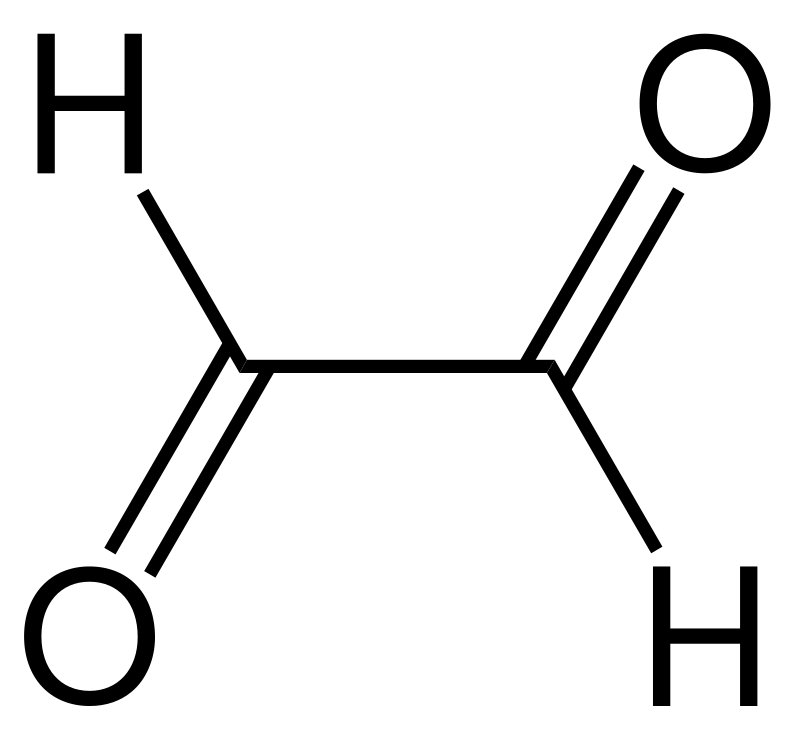The key difference between glycol and glyoxal is that glycol is any aliphatic diol, whereas glyoxal is the dialdehyde ethanedial derived from ethylene glycol.
Although the terms glycol and glyoxal sound similar, they are two different types of chemical compounds with different chemical structures and properties.
CONTENTS
1. Overview and Key Difference
2. What is Glycol
3. What is Glyoxal
4. Glycol vs Glyoxal in Tabular Form
5. Summary – Glycol vs Glyoxal
What is Glycol?
A glycol is an alcohol with two OH groups attached to adjacent carbon atoms. The most important glycol is 1,2-ethanediol, which is a sweet, colorless, and viscous liquid. This is the simplest glycol in this group, and it is commonly known as ethylene glycol. Therefore, the term glycol is often used to name this compound as a common term.
Glycols, specifically ethylene glycol, are often used as antifreeze in automobiles, brake fluid, HVAC systems, and in some human-made fibers. Ethylene glycol is an alcohol having the chemical formulaC2H6O2. The IUPAC name of this compound is ethane-1,2-diol. At room temperature and pressure, it is a colorless, odorless liquid that is sweet-tasting and viscous. This liquid is moderately toxic. The molar mass of ethylene glycol is 62 g/mol. The melting point of this liquid is -12.9°C, and the boiling point is 197.3°C. Ethylene glycol is miscible with water because it has -OH groups that are capable of forming hydrogen bonds.

Figure 01: Structure of Ethylene Glycol
There are two ways of producing ethylene glycol: industrial-scale production and biological route. In industrial-scale production, ethylene glycol is produced from ethylene. Ethylene is converted into ethylene oxide, which is then converted into ethylene glycol via the reaction between ethylene oxide and water. This reaction is catalyzed by acids or bases. If the reaction is done in a medium having a neutral pH, then the reaction mixture should be provided with heat energy. The biological route of producing ethylene glycol is via the degradation of polyethylene by gut bacteria of the caterpillar of the Greater wax moth.
What is Glyoxal?
Glyoxal is an organic compound having the chemical formula OCHCHO. It can be identified as the smallest dialdehyde having two aldehyde groups. This substance occurs as a white crystalline solid at low temperatures. It appears in yellow color at temperatures near the melting point. The vapor of this substance is green-colored.

Figure 02: Chemical Structure of Glyoxal
Typically, it is difficult to find pure glyoxal because it is usually handled as a 40% aqueous solution. Therefore, there is a series of hydrates of glyoxal that may include oligomers as well. Often, the hydrated oligomers behave equivalent to glyoxal. Industrially, glyoxal is made as a precursor for many other products.

Figure 03: Industrial Preparation of Glyoxal
When considering the production process of glyoxal, it was first prepared by the German-British chemist Heinrich Debus through the reaction between ethanol and nitric acid. However, in modern methods, this substance is commercially made from the gas phase oxidation of ethylene glycol in the presence of silver or copper catalyst or by the liquid phase oxidation of acetaldehyde with nitric acid.
What is the Difference Between Glycol and Glyoxal?
Glycol and glyoxal are organic compounds that are very important in the organic chemical processes. The key difference between glycol and glyoxal is that glycol is any aliphatic diol, whereas glyoxal is the dialdehyde ethanedial derived from ethylene glycol.
The below infographic presents the differences between glycol and glyoxal in tabular form for side by side comparison.
Summary – Glycol vs Glyoxal
Glycol is an alcohol with two OH groups attached to adjacent carbon atoms. Whereas, glyoxal can be described as an organic compound having the chemical formula OCHCHO. The key difference between glycol and glyoxal is that glycol is any aliphatic diol, whereas glyoxal is the dialdehyde ethanedial derived from ethylene glycol.
Reference:
1. “14.6: Glycols and Glycerol.” Chemistry LibreTexts, Libretexts, 4 Nov. 2021.
Image Courtesy:
1. “Ethylene glycol” By Sander de Jong – Own work (Public Domain) via Commons Wikimedia
2. “Structural formula of glyoxal” By Chem Sim 2001 – Own work (Public Domain) via Commons Wikimedia
3. “Industrial synthesis of glyoxal (acetaldehyde process)” By Chem Sim 2001 – Own work (Public Domain) via Commons Wikimedia
ncG1vNJzZmivp6x7pbXFn5yrnZ6YsqOx07CcnqZemLyue9ahmK1lmah6tbTEZpuinpaav6a6wp5km52krLKmuoygo7Kbn6F6orrDZp6lsZ%2Btrq17